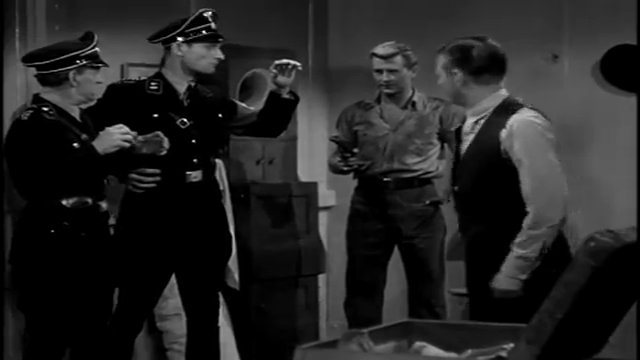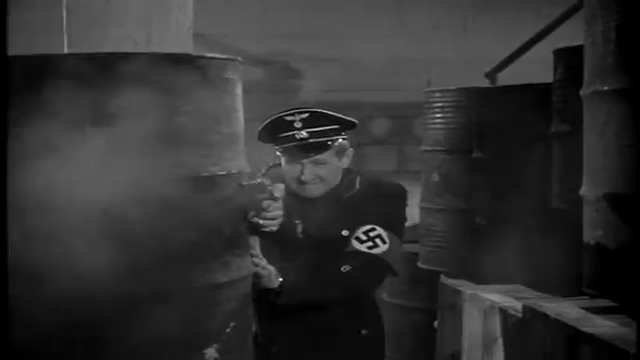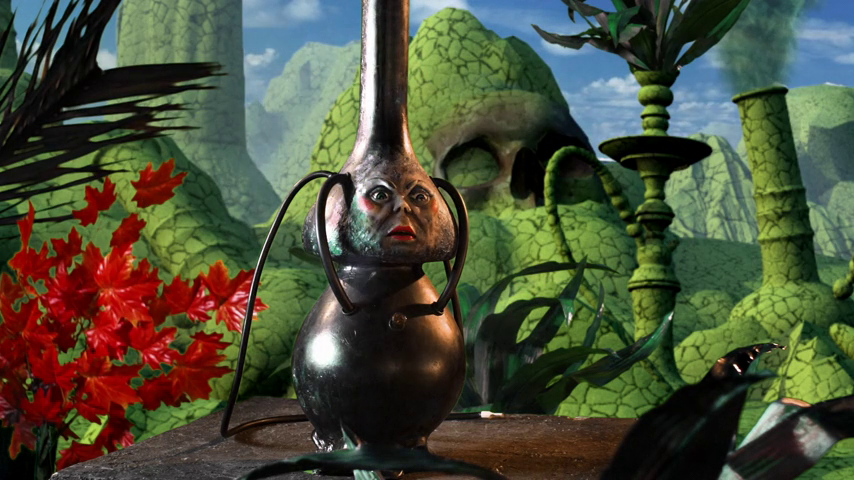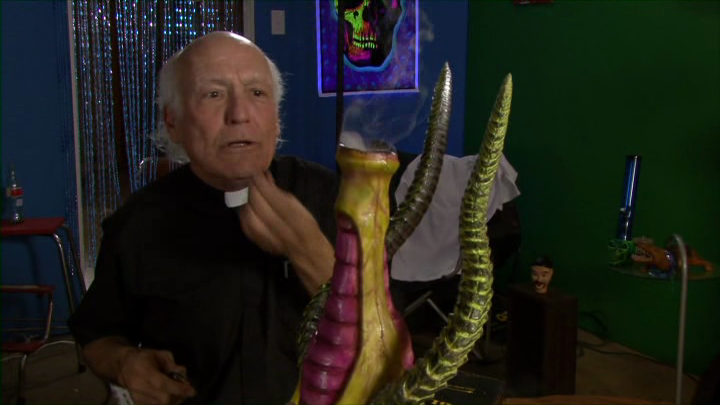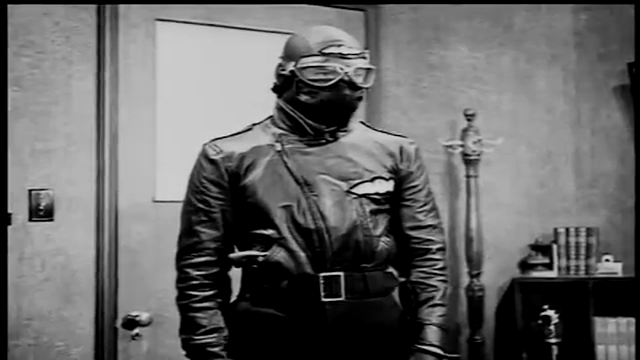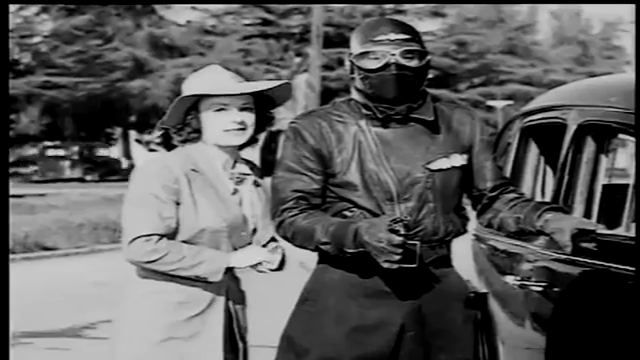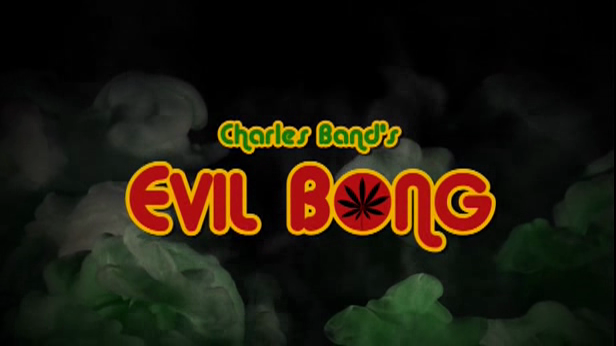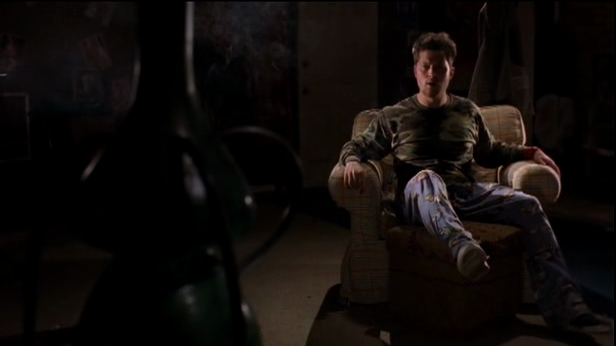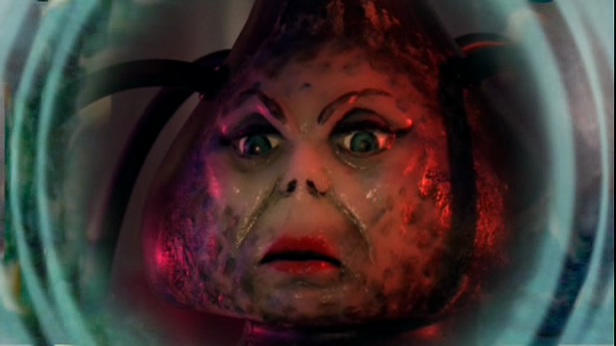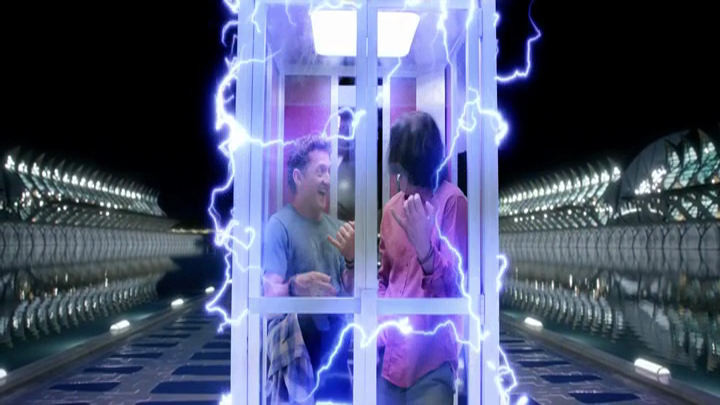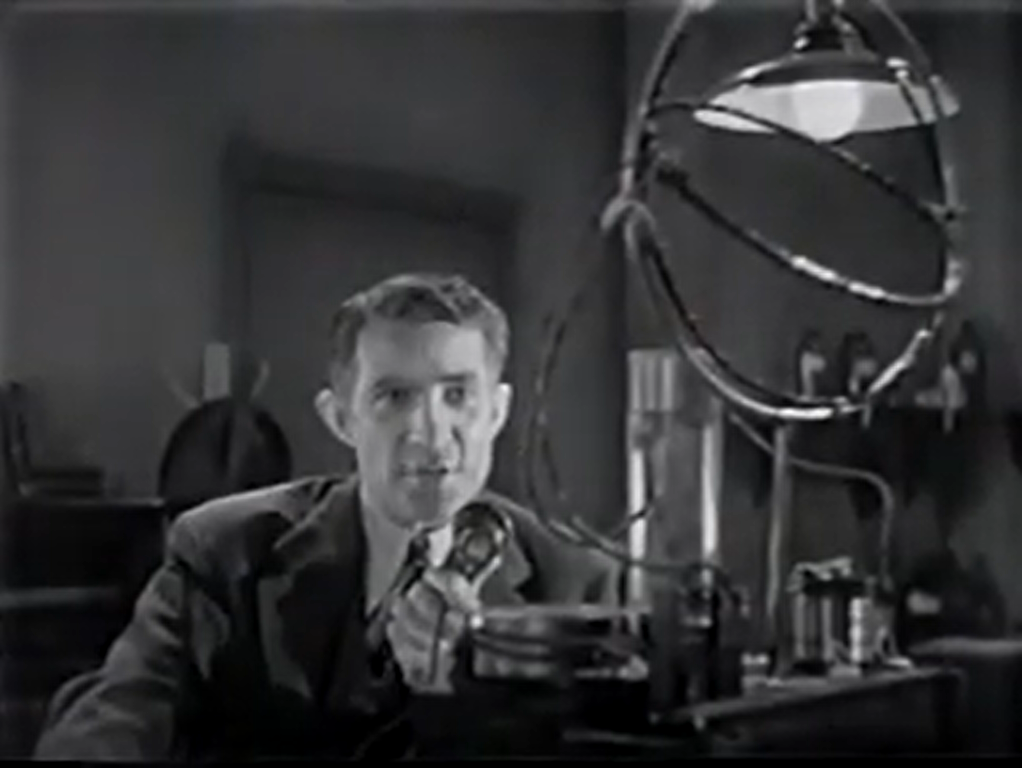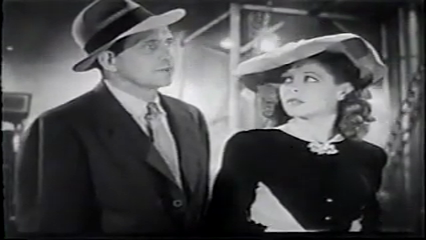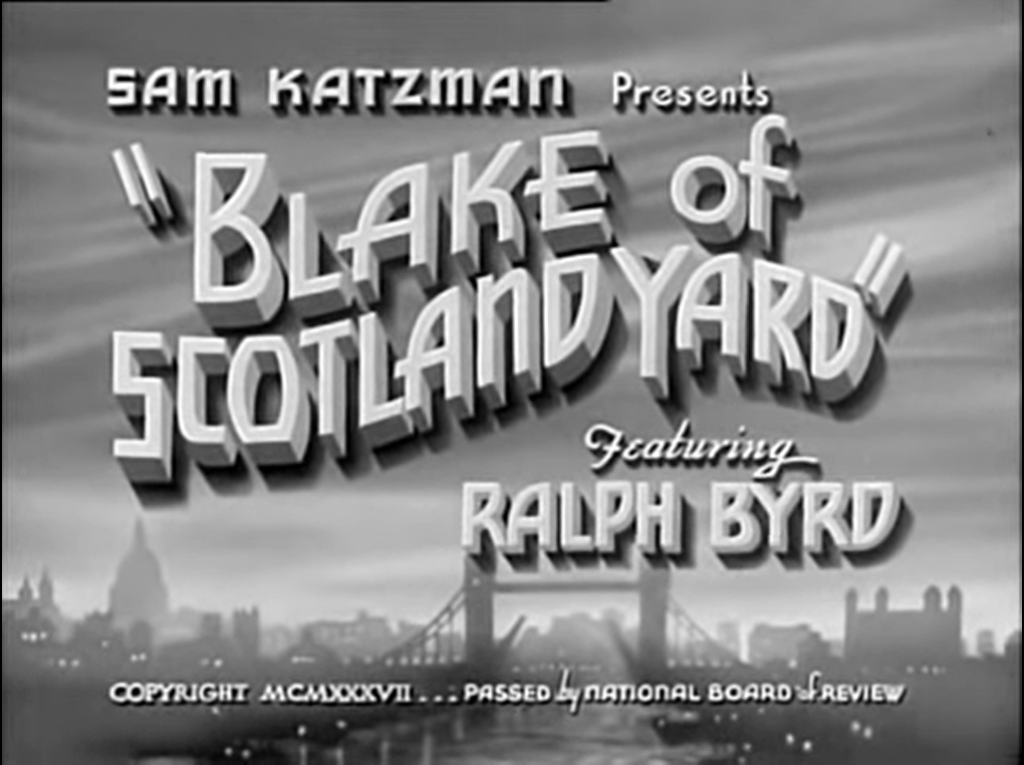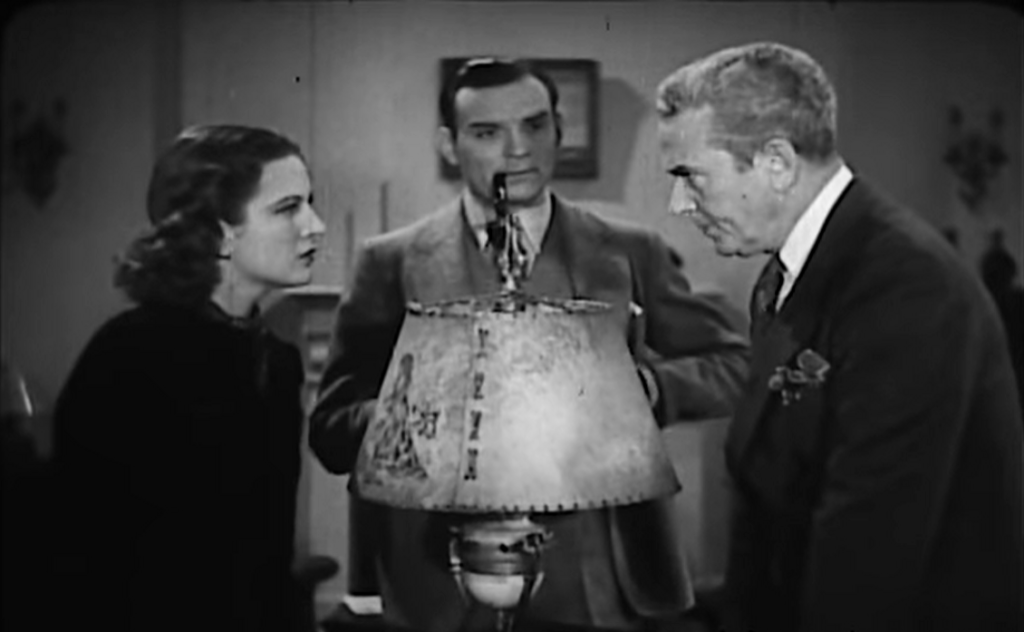-
#426 – Secret Agent X-9 (1945)
Secret Agent X-9 (1945)
Film review #426
Directors: Lewis D. Collins, Ray Taylor
SYNOPSIS: Shadow Island is an island in the Pacific ocean owned by American gangster Lucky Kamber. He has maintained his island’s neutrality during the war, but this has also meant it has become a hotbed for spies from all countries to visit and engage in shady activities. Secret Agent X-9 is sent by America to investigate a Japanese plot concerning something known only as element 722, teaming up with a Chinese agent and Australian spy to take on the Nazi and Japanese forces on the island.
THOUGHTS/ANALYSIS: Secret Agent X-9 is a 1945 serial comprised of thirteen chapters. The film takes place on Shadow Island in the Pacific Ocean, which has retained it’s neutrality on the ongoing World War II thanks to it’s owner Lucky Kamber striking a deal with the Japanese government. However, this neutrality brings in all spies from all warring nations, leading to a hotbed of subterfuge and sabotage. Japanese scientist Hakahima discovers an element known only as “722″ has the capability to replace airplane fuel when mixed with water, thus supplying an infinite fuel source. The head of the Japanese on the island, Nabura, devises a plan to send a criminal to the United States, whose face is altered by plastic surgery, to imitate the professor who discovered element 722 and get the formula from his office, which the professor himself believes to simply be a failed experiment. When Australian spy Lynn Moore learns of this, she informs her superiors, and the Americans send in secret agent X-9 to foil the plot, teaming him up with Chinese agent Au Fong. The setup to this serial is certainly one of the more interesting of the serials I have seen, with this island providing a unique setting for all the warring nations to scheme against each other. The back-and-forth plot of the protagonists sneaking around and attempting to foil the villains schemes is more typical of the serial format. However, there’s a good variety of settings and characters that keeps things interesting, alongside the tense relations between enemies that have to keep in line with the island’s neutrality. There is a lot of dialogue that simply repeats the plot points, but that’s not too uncommon for serials where viewers may not have watched all of the chapters.
The characters are a pretty interesting bunch, and offer a decent amount of variety. Many of the nations involved in the war are represented within these characters, with their own personalities that make them stand out. Secret Agent x-9 himself is played by a young Lloyd Bridges, and is definitely a strong lead, with his shiny blond hair, buff physique and charming personality. Au Fong, the Chinese agent, is played by Keye Luke, who played Kato in the Green Hornet serials, and is a good sidekick. Lynn Moore as the Australian double agent (who has an American accent) who pretends to work for Japanese forces with her radio broadcasts has a fair amount to do, particularly in comparison to other “token females” that are usually found in these serials. There’s also the Nazis that are fairly convincing in their full uniforms, as usually they are only referred to as a “foreign power” and never in the full uniforms. This goes a long way in giving the serial a convincing setting. The main protagonist is Nabura, a Japanese woman, who is played by a white American actress in makeup. This is not unusual at the time, but at least most of the other (male) Japanese characters are played by Asians. Her character comes across as sufficiently scheming and evil, but her portrayal by the actress constantly has her eyes half closed and looking at the floor as if she is reading her lines that are offscreen, which is distracting. Lucky Kamber, the owner of the island, in his portrayal in keeping the island neutral in the war, also has an interesting role as he tries to keep everyone else from tearing each other up. Other minor characters such as Solo, who sits at the same spot playing tiddlywinks for most of the film, and the French hotel owner Papa Pierre, also have their own personality and look which makes them fairly memorable and allow them to bring their own unique flavour to the scenes they are in. It is very rare to find a serial with such a varied cast and to make them interesting enough across the entire serial, but this serial definitely goes a lot further than others.
The setting of Shadow Island provides a decent variety of locations, from the casino, the Nazi ship and the hotel run by Pierre. They are all fairly distinct from one another, so the viewer can keep track of where they are. As mentioned, the characters all have a distinct appearance, from the Japanese soldiers to the Nazi uniforms, their is little doubt about who is who. Probably the weaker elements of the serial is the lack of action sequences, which revolve around the typical fistfights and car chases that you would expect to see. Most of the serial is focused on the intrigue and espionage played out through the characters, so it is important to follow the story. The cliffhangers aren’t too interesting, but there’s one or two novel traps the heroes have to escape from. Overall though, I think Secret Agent X-9 has an interesting and quite unique setup, alongside an array of distinct characters. The heroes are likeable, and the villains despicable, with a few morally grey characters as well to make things interesting. Some elements of the plot are a bit more typical, and the constant re-iteration of plot points can be a little tiresome. There’s less emphasis on action and more on espionage so perhaps some people (particularly younger viewers) may find it a little tiresome, but it distinguishes itself enough to make it a good and fairly unique example of the genre.
-
#425 – Evil Bong 420 (2015)
Evil Bong 420 (2015)
Film review #425
Director: Charles Band
SYNOPSIS: Having escaped the bong world, Rabbit sets up a bowling alley to fulfil his dreams. While he is welcoming his guests for the opening night, Ebee, the evil bong herself, along with the Gingerdead man, who is also trapped in the bong world, arrange to travel to the bowling alley and return Rabbit back to the bong world…
THOUGHTS/ANALYSIS: Evil Bong 420 is a 2015 comedy horror film and the fourth film in the Evil Bong film series. Following the last film, where Rabbit was trapped in the bong world, where the evil bong creates illusions to keep people their forever, he decides to follow his dream and opens a topless bowling alley where people can smoke weed. That…is basically the plot of the film. With a run-time of only fifty-three minutes, it’s barely a film at all, and even then it still seems to have trouble filling the screen with content. Most of the first half of the film is just dialogue, with Rabbit welcoming the various guests into the bowling alley. None of these characters are particularly interesting, and only serve as a stereotype to make very specific jokes. You would think that these characters are being introduced only to be killed off later as this is a horror movie after all, but no; none them are killed and only one gets an injury. The whole setup just seems pointless.
Apart from all the new characters that are introduced in the film for no reason, there are a few returning characters, such as Rabbit, who seems to have become the main character of the series now, and Larnell, who is stuck in a love triangle. Of course, Ebee the evil bong herself returns, but spends most of the movie in cut-aways to the bong world, where she engages in trash talk with the “gingerdead man.“ I imagine these scenes are hilarious if you’re stoned watching a bong and an evil gingerbread man arguing with each other, but otherwise they’re pretty uninspiring. The gingerdead man himself is a character from another film series (unsurprisingly called the gingerdead man) made by the same production company, and previously crossed over with the evil bong franchise in the Evil Bong vs Gingerdead Man film of 2013. The character himself is perverted, dirty and a nasty bit of work, but never gets round to killing anyone. The focus seems to be much more on the gingerdead man than the evil bong, which is distracting, and gives the film a different feel than its predecessors. All of the other characters apart from Larnell and Rabbit are however missing from this film, and that makes it feel pretty empty.
The Evil Bong series has definitely not been a high production affair, and Evil Bong 420 definitely continues that. The action is entirely limited to the bowling alley, which is in keeping with the minimal sets of the other films (although they had at least two or three). Someone at least knows how to frame a shot and edit a scene in this film, as even though the dialogue goes on for far too long, at least the camera work breaks up the monotony a little. The CG is pretty bad, but that’s expected. There’s definitely a change in tone with this film, as it doesn’t really make much attempt at a story, and instead just focuses more on being a lot more explicit and crude, mostly in the form of much more nudity and sex jokes. It overall feels a bit tasteless and devoid of any substance (not that there was much to begin with in this film series). On the one hand, I suppose it is appealing more to people who are watching this film while high, as they will have no real concern for the story, but the film still is mostly a lot of dialogue and set-up for things which don’t happen. There’s perhaps one or two funny jokes in the first part of the film, but the flat acting shaves off some of it’s impact. Overall, I think it’s fair to say that Evil Bong 420 is the low-point of the franchise (so far), and is fairly mindless in it’s story, set-up and characters, with an altogether tasteless and crude sense of humour.
-
#424 – The Clutching Hand (1936)
The Clutching Hand (1936)
Film review #424
Director: Albert Herman
SYNOPSIS: Dr. Paul Gironda has discovered a formula for turning ordinary metal into gold, a discovery that prove very valuable for the corporation he works for. Before he can reveal this discovery however, Dr. Gironda is kidnapped by a criminal known only as “The Clutching Hand,” and master detective Craig Kennedy is assigned to the case. Along with his journalist friend Walter Jameson and Gironda’s family, must find the professor and bring down the criminal plans of the clutching hand once and for all…
THOUGHTS/ANALYSIS: The Clutching Hand is a 1936 movie serial composed of fifteen chapters. It is based on the Craig Kennedy detective novels, most specifically, the final one that was written by their author Arthur B. Reeve. The film starts off with scientist Dr. Paul Gironda finishing a formula for synthesising gold. However, before he can reveal the formula to the board of directors for the company he works for, he is kidnapped, along with the formula. Detective Craig Kennedy is assigned to the case and along with his friend, journalist Walter Jameson, they work to find Dr. Gironda and stop the criminal mastermind known only as “The Clutching Hand” from obtaining the rest of the formula. The setup is a very familiar one in the serial format, and offers no surprises. The main problem with the story is just how boring it is. With a runtime of just over five hours, there needs to be plenty going on to keep the viewers interest, but there really isn’t. The constant back-and-forth between trying to rescue Gironda and finding the missing pages of the formula gets old fast, and there’s no real variety to the scenarios that play out on screen. Sometimes the serial just spends time explaining something that’s going on, which really drags. There’s a secondary plot concerning a criminal who has just been released from jail and his connection to Gironda’s family, but I didn’t even notice it while watching. At one point Gironda is rescued, only to be kidnapped again on his way home; it is really dull and repetitive.
The characters are again just the usual types as you see in these serials. Most of the time you’re just watching men in suits talk or throw punches at each other without much distinction. Craig Kennedy perhaps breaks the mould a little, in that he is not the young, dashing hero you would expect, but a more rough-looking, middle-aged detective. Gironda’s daughter and wife are the two female characters, who exist to either be kidnapped or provide secretarial duties. The Clutching Hand himself takes on the role of the masked villain whose identity is not revealed until the final chapter, and issues orders through a screen to his numbered henchmen. Again, nothing extraordinary there. The other minor characters are not worth remembering, as they serve little purpose other than to fill out the fight scenes.
The serial reminds me a lot of the Blake of Scotland Yard serial of 1937, in that it was produced by an independent company under similar constraints. But when the big studios were putting out serials like Flash Gordon in 1936, there’s no way these smaller serials would be of interest. There’s very few sets in this serial; and the constant re-use of a hotel setting where secret meetings take place makes you feel like you’re going around in circles watching the same thing play out in the same place chapter after chapter. The action scenes are dull and unchoreographed, with the film clearly being sped up to make it look more exciting, but the near-complete absence of any background music and the lack of choreography that shows when people fall over before they are even punched means it’s not very believable. The car chases have no interior shots of the passengers, and thus feel disconnected from anything plot-wise. Perhaps the only interesting part of the serial is the very end when (spoilers) The Clutching Hand is revealed to be Dr. Gironda himself, who apparently made up the formula for synthesising gold in order to recoup his massive losses on the stock market. It also turns out that his daughter is actually not his daughter at all, but that of the criminal Mitchell who we saw released at the beginning of the serial, and Gironda tries to find a way of disposing of him before he can learn the truth. This plot, while actually interesting, doesn’t really go anywhere, and has little impact on the main story. As the gold formula was a fake the whole time and Gironda wasn’t actually kidnapped, then you can conclude that the whole story was essentially pointless, and there is no payoff for watching five hours of this back-and-forth. I would advise skipping The Clutching Hand, it is a dull and poorly produced serial that, while having a few good ideas, simply doesn’t compete with the behemoths of the serial industry.
-
#423 – Evil Bong 3D: The Wrath of Bong
Evil Bong 3D: The Wrath of Bong (2011)
Film review #423
Director: Charles Band
SYNOPSIS: A strange meteorite crashes onto earth, and a man discovers a bong inside of it. Meanwhile, Alistair McDowell finds it later on alongside his old buddy Larnell, and when the bong coincidentally is bought by their old roommates Brett and Bachman, the group must again stop an evil talking bong from trying to take over the world…
THOUGHTS/ANALYSIS: Evil Bong 3D: The Wrath of Bong is a 2011 comedy horror film and the third film in the Evil Bong series. The film opens up randomly with a man burying his wife in the woods after he seemingly killed her. This plays no part in the story other than this opening scene. As he is walking home, he finds a meteorite that has crashed to Earth, and inside is surprisingly a bong. Later on, Alistair McDowell, the protagonist of the previous films, now working for the Space Institute, finds the meteor and undertakes an analysis. He runs into his old friend Larnell, who remarks he didn’t recognise him (a reference to his recasting, which was also done in the second film), and explains he has been training with a “ninja master,” and as usual is knee-deep in conspiracy theories. Meanwhile, Brett and Bachman, now running a weed shop, buy the mysterious space bong off the old man that found it in the meteorite, and find that it is once again an evil bong that wants to take over the world. The story is practically identical to the previous films: an evil talking bong is trying to take over the world, and anyone that smokes from it is taken into the inner “bong world” where the bong tricks it’s victims with illusions. The remaining cast must venture into the bong world to rescue their friends and defeat the bong. Simple stuff, but it has to be simple when you’re a film that’s designed for people to watch when high. Being the third film in the franchise (not since Attack of the Killer Tomatoes has a film franchise been so unnecessary), there’s actually evil bong lore that the film dives into which establishes continuity between the films, but as I said, you’re not going to be too focused on the plot when watching this.
The cast is made mostly up of characters from previous films, which provides a sense of continuity, even though it’s not necessary. Alistair, Larnell, Brett and Bachman are the same guys from the previous films, and nothing has changed much for them. Rabbit, the delivery guy who for some reason seems to have become a main character, is now a priest, and Larnell’s grandfather, now calling himself Dr. Weed, is fully converted to supporting marijuana after his escapades in the jungle in the previous film. And of course, the original evil bong herself turns up to offer advice on defeating the new space bong, with her usual sassy attitude. The expanded cast means there’s a bit of variety between their different perspectives, but there’s no stand-out performances of character developments.
The main problem with this film is it is almost exactly the same film as it’s predecessors, without adding anything new to proceedings. The effects are a bit better, and there’s more than two sets unlike the previous films, but there is so much time spent on the characters standing around talking that it becomes a bore. When characters start trying to explain their motivations it becomes difficult to follow, and there’s always a feeling of it simply not mattering whether you know their motivations or not. Ideally, the film should be breaking up this dialogue with some funny one-liners or jokes, but there’s barely any of that. The bong only really becomes the focus of the last act of the film, which under-utilises the main draw of the film. Despite all this, I think this one still improves on the second one just because of there being more than two locations, and the lore of the evil bong series starts to give the characters and ideas a bit more substance. The acting is still flat, and the budget is still low, but it’s still going to appeal to it’s target audience with plenty of weed smoking, ridiculous voice-overs, and partial nudity.
-
#422 – Captain Midnight (1942)
Captain Midnight (1942)
Film review #422
Director: James W. Horne
SYNOPSIS: Professor Edwards has invented a new type of radar that will surely help the U.S. government in the war effort. However, a foreign power has employed criminal mastermind Ivan Shark to steal the device for their own use. Ace pilot Captain Allbright uses his secret identity of Captain Midnight to try to stop Shark and his men before the device falls into their hands, and to stop Shark’s bombing of American cities using his own aircraft…
THOUGHTS/ANALYSIS: Captain Midnight is a 1942 movie serial based on the radio plays of the same name. The plot is fairly straightforward and very familiar if you’ve ever seen a movie serial from this era: Ace pilot Captain Allbright uses his masked alter-ego Captain Midnight to stop a criminal from stealing a new weapon and selling it to an enemy government. It’s the same plot used through many wartime serials that would have had contemporary relevance. Unfortunately, there isn’t much content to separate it from the rest of similar serials, as there are plenty that use masked alter-ego’s, and also lots that centre around the use of planes. While using the characters from the popular radio play would have brought in extra viewers, there isn’t much uniqueness that viewers will get from the serial. The villain’s plots of stealing a new invention and bombing American cities are a bit interchangeable, and the serial moves back and forth without any real continuation or progression of the plot, resulting in very little development over the course of the fifteen chapters. Like every other serial, each chapter ends in a cliffhanger in which Captain Midnight faces certain doom only for it to be quickly resolved at the beginning of the next chapter. While these resolutions are usually anti-climactic, the serials produced by Columbia Pictures often have the least creative solutions, with Captain Midnight mostly just escaping car crashes or explosions by just walking from them a little dazed. In one such cliffhanger, he just walks away from a plane crash and jumps into a fistfight, which is quite ludicrous even by the serial’s standards.
Captain Allbright/Midnight is the typical serial hero: the square-jawed all-American hero who gets into plenty of fights and daredevil escapes. There doesn’t seem to be much point in his alter-ego: everyone seemingly knows who he is, and it wouldn’t matter if he was exposed or not. His “Secret Squadron” who aid him in his heroic deeds don’t really have a part to play, and what little we see of them shows they only fill very typical roles of sidekicks. Major Steele, Midnight’s government contact, is the authority figure who gives the orders and who Midnight plans with to catch the villains. The main villain himself, Ivan Shark, has a distinguishing trait in that he is a master of disguise, and subsequently disguises himself as a number of the serial’s characters over the course of the fifteen chapters; including Captain Midnight himself. His disguises also come with dubbed voice-overs of the characters he is playing, which is very obvious. It’s a trait that was used by the protagonist in The Spider serials, and definitely used to better effect there. Shark’s daughter Fury (that is her name apparently) has a role as second-in-command, but doesn’t really play much of a part. At the start of the serial, she seems reluctant to follow some of her Father’s schemes, leading me to believe she may be a character that swaps sides and questions her loyalties, but that is perhaps too complex for this serial, as this trait is soon forgotten and quickly becomes just another flat villain giving orders.
The main problem with Captain Midnight is that it’s story goes nowhere. There’s no build-up, and the focus keeps shifting so it feels like nothing of consequence is happening, which means it is going to be difficult to keep viewer’s attention over the course of fifteen chapters (or four and a half hours). Some of the stunts are decent, but nothing too outstanding, and there’s not enough plane-based scenes that you might expect from the titular character. The villain’s motivations are confused and all over the place, which further confounds any attempt to advance the plot. Although it doesn’t stray from the typical serial formula, there’s definitely better examples of the format you can watch.
-
#421 – Evil Bong 2: King Bong
Evil Bong 2: King Bong (2009)
Film review #421
Director: Charles Band
SYNOPSIS: Alistair McDowell visits his three former roommates after one of them tells him they’ve all had strange things happening to them. Alistair surmises that they are all suffering from side effects of smoking from the evil bong that they previously destroyed when it attempted to steal their souls. They contact the delivery man who delivered the bong, who tells them that the bong originated from a tribe located in the Amazon, and so the group head into the rainforest to find answers and try to cure themselves from the side-effects which have afflicted them…
THOUGHTS/ANALYSIS: Evil Bong 2: King Bong is a 2009 comedy horror film and the sequel to the 2006 film Evil Bong. The film starts off with Alistair visiting Larnell at his new apartment. Larnell remarks that he hardly recognises Alistair; a sly reference to the fact that it is a different actor playing him than the first film. The reason Larnell called Alistair over is that he and his roommates have all been afflicted by strange changes: Larnell’s libido has gone into overdrive, Bachman has developed narcolepsy, and Brett has become morbidly obese, adding strain to his relationship with his girlfriend. Alistair guesses that it must be a side-effect of them smoking from the evil bong of the first film, and tries to learn more about it. The only lead they have is the delivery guy who delivered the bong, who they arrange to come round. He tells them the stories that he himself was told when he picked up the package about how the owner picked it up when he was serving in the Amazon with the peace corps. With this in mind, the group (including the delivery guy for some reason), head to the Amazon to find the tribe and get some answers. As with the first film, the film’s plot is fairly simple. Most probably because this is designed to be a film that you watch while smoking weed yourself. There’s more of a plot than the previous film though, and everything is simple enough to follow, so that’s a plus.
The group arrive in the Amazon where they meet a scientist who has discovered a new type of marijuana that has extraordinary medical properties. When the group smoke this, they are cured of the afflictions of the evil bong. However, another of the scientist’s plans to use the new weed to sell it on the streets and become rich. He reforms the evil bong from the first film with the fragments that Larnell saved, and encounters the tribe alongside a more powerful bong called King Bong. When this new bong takes the delivery guy into his inner realm, the group decide to go and save him, with the original evil bong supporting them (apparently she is King Bong’s ex; don’t ask me how bong relationships work…). The climax is pretty similar to the first film, with the group venturing into the inner bong world where people are tricked by illusions that the bong creates. There’s nothing too spectacular about the finale, and it is resolved in the way you’d expect. The characters are pretty much the same from the first film, and the new characters add very little outside of the typical roles they fill.
Like the first film, the budget for this film is spectacularly minimal, but it does do a bit more than it’s predecessor by doubling the amount of settings from two to about four. The “Amazon” is clearly just some woods, and the bong world has nothing remarkable about it. I think the film flows better than the original, and has a few more laughs, but overall any improvements are minor. It’s not any worse, but not too much better. Like the first, you’re only going to find some value in this if you’re already high and can ‘enjoy’ the imagery and simple gags that won’t go over your head. Overall, Evil Bong 2 is a mild trip that is slightly better than the original, but still doesn’t live up to the ridiculousness of the premise that the title provides.
-
#420 – Evil Bong (2006)
Evil Bong (2006)
Film review #420
Director: Charles Band
SYNOPSIS: Alistair McDowell rents a room with Larnell, Bachman and Brett, three other college students, who are obsessed with smoking weed. Larnell orders a large bong online that apparently is possessed, and the three roommates (excluding Alistair) enjoy it’s benefits. However, things take a dark turn as the bong starts killing them off one by one after they smoke from it and are taken into the “bong world” where the spirit of the evil bong has total control, and enacts a deadly plan to turn the world into eternal stoners…
THOUGHTS/ANALYSIS: Evil Bong is a 2006 comedy horror. The film starts out with a college student named Alistair McDowell going to rent a room with three other students, all of whom continually smoke weed (while Alistair never does, he is not opposed to them doing it). With Alistair’s rent money, Larnell, one of the other students, now says he has enough money to buy an extravagant bong he has found online. There is a warning from the previous owner that the bong is possessed, but that doesn’t stop Larnell from purchasing it. When it arrives, the three (excluding Alistair partake in smoking from it. Later that night, Bachman hears the bong calling him and when he smokes it, is transported into the “bong world” where the bong has the power of illusion and kills Bachman. The remaining roommates notice that he is dead in the morning and attempt to hide his body when Larnell’s grandfather pays a visit. As the film progresses, the rest of the cast are sucked into the bong world as the evil bong grows more powerful, leaving Alistair to enter the bong world himself in order to defeat it. The plot of the film is rather minimal: there’s an evil bong that kills people when they smoke from it. That’s the movie. One of the key things about this film is that it’s more than likely aimed at people who are already high when they are watching this, so they aren’t going to really be able to follow an intricate story. With that in mind, the film just needs to have a few cheap laughs and some surreal imagery and I suppose it does that in the most minimal way possible, with some unoriginal funny lines that may get a chuckle because they always do no matter where they’re used, but again, anything more complex probably isn’t going to get the audience’s attention.
The characters are all pretty bland, with their personality consisting of exactly one trait. Alistair is the straight-laced nerd, Larnell is a typical stoner, Brett is a jock, and Bachman is a “surfer dude.” They have no personality outside of these tropes. You can quite easily swap around the latter three and it would have no effect on the story, as each of their “unique” personalities contributes to about one joke each in the entire film. Some other minor characters include Larnell’s grandfather, whose one extended scene adds nothing to the film, and also the evil bong’s former owner, played by Tommy Chong (look him up if you don’t know who he is). There’s also a fair few cameos from characters from other films made by the same production company, but I didn’t recognise any of them because I haven’t seen any of the movies. The only one I have seen is the Trancers series, from which Jack Deth makes a brief cameo, but I didn’t recognise him, and I’m not sure anyone would since the Trancers series is hardly a keystone of film history (despite their being six films in the series). The evil bong herself is an animatronic face with limited movement (the lips definitely don’t sync to the words she says), and it’s a bit trippy, but nothing amazing.
I’m going to assume that this film had no budget, as the entirety of the film takes place in the roommates apartment. The various characters come in and out, but most of the time it’s just the four main guys bantering or smoking weed. The only other location in the film is the “bong world” where everyone goes after they have inhaled from the bong. This world is apparently a strip club where the bong has the powers to create illusions and kill those who are trapped there. It’s a fairly drab and dark setting so you can’t really see what’s going on, but undoubtedly viewers will be more focused on the semi-nudity in these scenes anyway. There’s some surreal-ish imagery that accompanies these scenes with marijuana leaves flying around the screen and a hazy border around the film, but it’s hardly psychedelic and mind-bending…unless you’re already high I suppose. Overall, Evil Bong is a pretty stupid film, but it knows it and doesn’t try to be anything else. It’s obviously intended as a film to get high and watch, so there’s nothing remotely complicated, and also nothing to really make sense of.
-
#419 – Bill and Ted Face the Music (2020)
Bill and Ted Face the Music (2020)
Film review #419
Director: Dean Parisot
SYNOPSIS: Bill S. Preston esquire and Ted “Theodore” Logan were supposed to unite the world through their music. Nearly thirty years after they played a gig to the world, they are still yet to write the song that will they are destined to actually unite the world with. Now married with grown-up children, Bill and Ted are confronted with their failure by being told that reality will cease to exist unless they can write the song. Bill and Ted have the idea to travel into the future and take the song from themselves when they’ve written it, while their daughters Billie and Theo travel into the past to gather up some famous musicians to help them out. However, the Great Leader of the future has lost faith in the duo, and has sent a killer robot to track them down through time and kill them, believing that their deaths may be able to save reality…
THOUGHTS/ANALYSIS: Bill and Ted Face the Music is a 2020 sci-fi comedy film, and the third film in the series, after 1991′s Bill and Ted’s Bogus Journey. The film opens thirty years after the events of the previous film, with Bill and Ted playing the music for the wedding of Ted’s younger brother Deacon, and Missy who was Bill’s step-father in the first film, and Ted’s step-father in the second, which makes for a humourous scene that brings together a lot of the characters of the previous films, and shows what they have been up to in the twenty-five years since we saw them last. However, for Bill and Ted themselves, the last twenty-five years have not been so kind, as they have constantly failed to fulfil their destiny and write the song that will supposedly bring universal harmony and save reality. They are summoned to the future where they are asked to explain their actions, but their usual charm doesn’t seem to be working this time. They are forced to work on the song as the timer counts down to when they must perform it. They have the idea to instead travel to the future and take the song from themselves when they have written it, and so begins another ‘excellent adventure’ for the duo as they travel to various points in their future to find the song they supposedly have to write. After a thirty-year gap between films, there is undoubtedly a lot of expectations for someone who grew up watching these films for this new one to live up to the nostalgia of the first two. Thankfully, and perhaps even surprisingly, this film manages to capture the feel of the previous films, while also taking them somewhere new through the future and possible realities. At the heart of it though, is still this unshakeable friendship between two rock-loving guys which forms the basis for bringing out the very best in the entire universe. The film acknowledges its predecessors through both returning many of the characters, and also small little references which will make you laugh if you recognise them. The Bill and Ted films were never perfect or perfectly-polished masterpieces; they were just a fun adventure about two ordinary guys who have extraordinary adventures, and this film fits in perfectly to that. It didn’t have to be made, but it was made for the fans that have such a fond memory of the films, and through the return of the original writers and many of the characters, it’s hard to see how they could have made a better movie to round off the trilogy. Like I say, the previous films aren’t perfect and neither is this one, but again that nevertheless binds them together.
The main plot of the film is mostly split into two: firstly, you have Bill and Ted travelling to visit themselves in the future to find the song that they will supposedly write, and take it back to the present. In doing so, they come across many versions of themselves where they didn’t write the song, and their lives have fallen apart, including their wives leaving them. Bill and Ted, through this constant time-hopping, are brought into contact with the consequences of their actions, and try to avoid their bad futures by fixing the present. This again reflects the tireless wholesomeness of the duo as they recognise their mistakes and try to do everything they can to fix them. They are also being chased down by a robot from the future, sent by the Great Leader who believes that since Bill and Ted fled from the future and making the song, another interpretation of how to save reality would be to kill them, and so she sends the robot to do it. The series has never really needed villains: in the second film, the villain doesn’t really have much of a role to play himself, but rather just sets things in motion. The driving force of the films has always been about Bill and Ted learning something and improving themselves, rather than defeating an overarching villain, and again, this film does that too. The killer robot does have a small redemption arc as he is integrated into the cast, and it again shows how Bill and ted can win over just about anyone. The other main plot point concerns Bill and Ted’s daughters Billie and Thea, as they try and help their Dad’s out by travelling into the past and collecting famous musicians to help with performing the song. This element of the plot is a little weaker than the scenes focusing on Bill and Ted, and is quite similar to the first film. Nevertheless, there’s still plenty of laughs to be had, and Billie and Thea are genuinely likeable characters, in that they reflect their Father’s mannerisms and optimism, combined with being adults of the 21st century. More could have been done with their characters, but I think keeping focus on Bill and Ted themselves is the appropriate decision. Kelly, who is the daughter of Rufus, the duo’s mentor from the first two films, is also a fun character who doesn’t have the coolness of her father, but is still doing her best. Although she is not her Father (the actor who played him, George Carlin, passed away between the film), her belief in Bill and Ted reflects that constant returning theme of how a simple optimism, while not being afraid of confronting reality, can make a difference, even if you’re not as cool as Rufus.
As I mentioned, i have very little criticisms regarding the film, but there are definitely some things which stand out as being issues. While the majority of the film is well balanced and structured, the last part feels a bit rushed, with everyone getting together and a lot of references being used which leaves little time to appreciate them, and the magnitude of, for example, returning from the dead. Perhaps the main hindrance is the lack of budget: it is obvious that a lot of the scenes from the future etc. are done on greenscreen, and makes some of them feel a bit static and lifeless compared with the energy and often weirdness we got in the previous films. None of the films are very high budget, and that’s part of the charm in that the ordinariness of the leads juxtaposes against the bizarre situations they find themselves. The ending of the film had a revelation that was quite easy to spot ahead of time, and it accomplishes what you expect and want it to: it goes big for the big finale which saves reality, but again I feel like it needed just a little more spectacle than the budget could afford. Nevertheless, It is definitely satisfying, and does the story justice. One cool little feature is that the countdown to the time that Bill and Ted have to perform their song is exactly in synchronicity with the runtime, adding that little extra investment. The song itself that they perform is pretty much perfect: it combines a host of instruments that encapsulate the diversity of reality while having that distinct classic rock/metal sound that Bill and Ted is known for. The fact that it has no lyrics also reflects how the power of music transcends language. It sounds like the song I’ve been waiting thirty years to hear. The more I think about it, the more I appreciate it, and I think this just reinforces just how this film nailed exactly what Bill and Ted is about and how it did exactly what it needed to thirty years later.
Overall, Bill and Ted Face the Music is a worthy, and fully-formed addition to the beloved series: it doesn’t feel like a cash-in or a pointless add-on, but takes the characters people remember fondly and allows them to fulfil the potential they have been destined for for thirty years. It’s a love-letter to those people who grew up with the characters and have a nostalgia for them, and the film never feels like a disservice to that nostalgia, which in itself is a remarkable achievement if you look at other franchises which try to do the same thing. Even though the previous films explored all that could be explored through both the past and after-life, Face the Music still offers something new in the travels through the future and confronting their alternate selves, and the weight of their actions. Throughout it all, even when Bill and Ted are despondent in their lack of success in writing their world-changing song, their simple, but persevering optimism always sees them through the darkest of times. Alongside this, this optimism does not blind them to confronting the mistakes they have made, and are constantly trying to fix things (they continually “face the music” in more ways than one). Face the Music really captures the themes of the series, and brings them together in a satisfying way. It’s not a perfect film, but neither were it’s predecessors, which makes them fit together well. The film is visually hampered by it’s lack of budget and over-reliance on greenscreen, but those are really minor issues that don’t detract from the film’s story and message. For any fan of the previous films who remembers them fondly, Bill and Ted Face the Music is both a worthy tribute and a successful continuation of the story of two ordinary teenagers who have gone on to accomplish extraordinary things.
-
#418 – The Secret Code (1943)
The Secret Code (1943)
Film review #418
Film director: Spencer G. Bennet
SYNOPSIS: Dan Barton, a police officer, is assigned by his boss to infiltrate a Nazi spy ring operating in the country. To do this, Dan is framed for a murder and discharged from the police service, but before his Boss can tall anyone else what his mission is, he is murdered, which means that no one knows that he is undercover. Dan begins to try and gain the trust of the Nazi spies, while also donning the mask of the “Black Commando” to sabotage the saboteurs.
THOUGHTS/ANALYSIS: The Secret Code is a 1943 movie serial comprised of fifteen chapters. The serial opens up with Dan Barton, a police officer, being assigned to go undercover to infiltrate a Nazi spy ring operating somewhere in the city. He is framed for a murder and discharged from the police to give himself a cover story, while only his boss knows the true story. However, when Dan’s boss is killed himself, there is no one else who knows about the undercover operation, and so he must bring down the spy ring without any help from the police, who are looking to arrest him. He does get some help. however, from his friend in the police Pat Flanagan, and a reporter whose curiosity gets her involved. Dan joins the Nazi spies on various operations, but also secretly dons an all-black mask and suit, calling himself the “Black Commando,” and sabotaging their operations with the knowledge he has of them. This serial does change up some of the typical setups of the format; most notably where usually the masked villain is usually one of the heroes allies, here the masked hero is one of the villain’s seeming allies. The rest of the story setups are pretty standard though. The main objective for Barton is to obtain the “secret” code that the Nazis are using to send messages to their spies. The Nazis get their messages through a large light-up screen, where squares with numbers flash up on the screen and they are able to decrypt them for orders. The theme of codes runs through a lot of the story, showing how spies might receive their instructions through various coded ways, which I’ll discuss later on.
What makes the serial unique from all of the other war-time serials I’ve seen is that they actually refer to the villains as Nazis, while usually they are referred to as simply “a foreign power” (the same holds true for when the villains are Japanese but that’s more obvious when the actors are adorned in make-up to “look” Japanese). On the screen where their orders are given, a swastika or picture of Hitler himself is shown before the message begins, as the spies salute him and proclaim “Heil, Hitler” in authentic Nazi style. One of the little things I noticed in one of these scenes where they are filmed from behind, one of the actors clearly has his fingers crossed behind his back. Obviously all the actors are American and wouldn’t really salute the Nazi leader, and I wonder whether the actor knew he was being shot from the back or front; either way, these serials were pumped out in about a month, so there was never any time for re-shoots to edit out these hiccups. It should be of no surprise that this serial is a big chunk of war-time propaganda, attempting to educate the American public on the tactics of spies and the codes they use. The use of referencing the actual Nazis also puts things into focus with regards to who the enemy is.
The characters themselves are pretty bland. Barton is a typical main lead, his friend Pat Flanagan is the most stereotypical Irish friend character imaginable. His go to line is that everything that happens to him is the “luck o’ the Irish” is just a replacement for any kind of actual character, and he only seems to have an Irish accent when he needs to reference the fact that he is Irish. The female reporter is the typical sole female token character who is always either a reporter or a secretary, since apparently those are the only two jobs a woman in the 40′s could do, or could be seen to do on film anyway. The Nazi villains are also fairly bland, and the consistency of their accents fluctuates wildly. The masked identity of the Black Commando is not noteworthy, as it’s just a completely black suit and mask, without any unique characteristics or abilities. The acting across the characters is unremarkable, although there’s a few moments where actors clearly miss their cue and say their lines a little too late. All in all, nothing stands out in terms of the characters.
Perhaps the most unique and bizarre aspect of this serial is at the end of the each chapter. There, we are treated to a scene in the office of U.S. “army intelligence officer” Henry Burton, who speaks to the viewer directly about the different types of code enemy spies use, and what the public might be on the look out for. First of all, he is clearly not an actual member of the U.S. army, but another actor. Even if you don’t know this from looking up the credits, you can tell he fumbles his lines often when he actually has to decrypt the code on the blackboard, even though he probably has the answers offscreen, he hesitates when he has to do some actual decoding, and sometimes even says the wrong thing while writing the right answer on the board. The segment shows a number of interesting ways of making and breaking codes, but some of them are a little far-fetched, such as the one about the contents of a spy’s pockets forming a code, but there was no way you could have deduced the order the items should have been in order to decrypt it. It’s a nice bit of trivia, but it’s application to reality (like most propaganda) is dubious.
Overall, The Secret Code offers a few different takes on serial tropes, but is let down by lacklustre characters. The context of a war-time serial means it is bloated with propaganda and messaging, but is able to be much more direct with it than other serials at least. It’s unique enough that it might be worth a watch for serial enthusiasts, but it’s definitely a product of its time.
-
#417 – Blake of Scotland Yard (1937)
Blake of Scotland Yard (1937)
Film review #417
Director: Robert F. Hill
SYNOPSIS: Sir James Blake is unveiling a new invention to the League of Nations which will ensure world peace, however, the presentation is interrupted by a criminal mastermind known only as “The Scorpion,” who wishes to steal the invention for his own nefarious uses. Jerry Sheehan, an American who has helped create the invention along with Blake’s niece Hope, works with Blake, Hope and their friends to find the invention and uncover The Scorpion’s true identity.
THOUGHTS/ANALYSIS: Blake of Scotland Yard is a 1937 movie serial composed of fifteen chapters released by Victory Pictures. Interestingly enough, a serial of the same name was released ten years prior by Universal Pictures, directed by the same director as this one. It is unfortunately a lost serial and no footage seemingly exists, but from what I can tell, it was quite different from this one, and none of the characters are the same, meaning that this serial is just capitalising on the name of it’s predecessor and it’s sequel, which is quite an odd move considering that ten years is a large gap in a time when there would have been no way to re-watch these serials unless they were re-run in theatres. maybe they bet on adults recognising the name and taking their kids to go see it. Anyway, the serial starts off with Sir James Blake, a retired inspector at Scotland Yard, unveiling an invention he has made along with his niece Hope and their friend Jerry. They are presenting it to the representatives of the league of Nations as a device that can target and destroy battleships from over one hundred miles away. They plan to donate it to the League of Nations to ensure world peace; which is an interesting way of creating peace by giving countries the unlimited capacity to blow each other up. What do they call this miraculous device? a “death ray.” Yes, the architect of peace named the death ray, will surely stop all wars. Nevertheless, the demonstration is interrupted as a criminal mastermind known as “The Scorpion” shows up with his goons and steals the device, hoping to sell it to a foreign power. This sets up the typical serial premise of the heroes foiling the criminal’s various schemes while attempting to unmask him, and for the most part it really falls into the standard serial format without exception.
I suppose what makes the serial unique is that it is set in England, which is different from the usual serials set in unnamed U.S. cities. The trouble is that it is obviously made in the U.S. with American actors, and none of them really make an effort to use an English accent. It sometimes sound likes they’re trying to put on an accent, but it definitely doesn’t sound English. The only character who has an excuse is Ralph Byrd’s character Jerry, who is meant to be American, and who also seems to try and sound a little English. This is Byrd’s first serial appearance, from which he would go on to star in S.O.S. Coast Guard and Dick Tracy in the same year, eventually setting him up to play Tracy in various serials, feature films and TV shows until his death in 1954. One of the running jokes (if you can call it a joke) is that Hope’s kid brother Bobby occasionally uses American slang and phrases, which he or Jerry have to explain to the rest. In one scene, Jerry jokingly chastises Bobby about needing to speak “proper English,” which is completely bizarre considering Jerry is the American, and everybody else also doesn’t seem to speak “proper” English. Bobby is also probably the only character who makes a more significant effort to speak an English accent. Despite the title, there’s not really much in the way of police or detective work, and we only see Scotland Yard itself in one scene. As mentioned, it seems the serial is relying on the name for recognition only. The Scorpion as the villain always walks around with a hunched back, and always covers his face with a claw on his hand (he also wears a mask as well, but we never really see it because of the aforementioned claw). Why the claw? To fit with the “Scorpion” name I guess? Why is he always covering his face with
The action is split between a number of locations which adds a small amount of variety. Most of the action is set in Blake’s stately home, which has a number of secret passageways, underground tunnels and spy-holes for all sorts of tricks to play out. There is also the gang’s hideout in London, where we see stock footage of the London skyline and a street scene which I guess looks London-esque. They could have definitely utilised it more though to give the serial a unique setting. There’s also a good chunk of the serial that takes place in Paris, specifically a café and a hotel. These scenes often feel completely pointless, consisting of some odd dancing by a couple who hate each other, who are also spies…or something like that? it’s really difficult to follow, and frankly very boring. There’s no real sense of it being in Paris either, apart from one guy wears a stripy shirt and another woman a beret in typical style.I think they’re also trying to put on French accents, which is about as successful as the attempts to do English ones. There’s a lot about this serial which just pads out the time, and offers very little to the story (of which there is little anyway). A seventy-minute feature film version was released along with the five-hour serial, which I assume was able to cut out almost all of these pointless scenes, and shows just how much of the serial was inconsequential.
Despite the variety of locations, the sets feel very empty and dull, with no real character to them. There’s not really much action as in other serials, as most of the chapters revolve around following henchmen, or devising a trap to capture a henchman. While most serials throw in a fistfight and vehicle chase almost every chapter, this one doesn’t, and unfortunately doesn’t offer anything interesting to replace it. The identity of The Scorpion when it is revealed is a surprise, but doesn’t really have any ramifications. One of the most distracting things about the serial is the lack of background music. It makes whole scenes completely lifeless, especially the fight scenes, which lack any sort of energy. Overall, as you can probably guess, Blake of Scotland Yard is not a very good serial. Considering we were getting serials like Flash Gordon at around the same time, there’s no way a barebones serial like this could offer anything exciting. The plot is very typical of the serial format, but manages to make it needlessly complicated and difficult to follow across all the locations and the spying, doppelgangers and betrayals that obfuscate the flow of the story. The setting in an English stately home is novel, but undone by sparse sets and lack of appropriate accents. Byrd as the lead gives a charismatic and charming performance, but the rest of the cast are dull and without merit, and Byrd shines much more in his role as Dick Tracy. Give this one a miss, you are not missing much.



